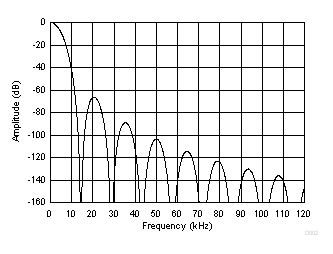SBAS760C March 2018 – January 2019 ADS1260 , ADS1261
PRODUCTION DATA.
- 1 Features
- 2 Applications
- 3 Description
- 4 Revision History
- 5 Device Comparison Table
- 6 Pin Configuration and Functions
- 7 Specifications
- 8 Parameter Measurement Information
-
9 Detailed Description
- 9.1 Overview
- 9.2 Functional Block Diagram
- 9.3 Feature Description
- 9.4
Device Functional Modes
- 9.4.1 Conversion Control
- 9.4.2 Chop Mode
- 9.4.3 AC-Excitation Mode
- 9.4.4 ADC Clock Mode
- 9.4.5 Power-Down Mode
- 9.4.6 Reset
- 9.4.7 Calibration
- 9.5 Programming
- 9.6
Register Map
- 9.6.1 Device Identification (ID) Register (address = 00h) [reset = xxh]
- 9.6.2 Device Status (STATUS) Register (address = 01h) [reset = 01h]
- 9.6.3 Mode 0 (MODE0) Register (address = 02h) [reset = 24h]
- 9.6.4 Mode 1 (MODE1) Register (address = 03h) [reset = 01h]
- 9.6.5 Mode 2 (MODE2) Register (address = 04h) [reset = 00h]
- 9.6.6 Mode 3 (MODE3) Register (address = 05h) [reset = 00h]
- 9.6.7 Reference Configuration (REF) Register (address = 06h) [reset = 05h]
- 9.6.8 Offset Calibration (OFCALx) Registers (address = 07h, 08h, 09h) [reset = 00h, 00h, 00h]
- 9.6.9 Full-Scale Calibration (FSCALx) Registers (address = 0Ah, 0Bh, 0Ch) [reset = 00h, 00h, 40h]
- 9.6.10 IDAC Multiplexer (IMUX) Register (address = 0Dh) [reset = FFh]
- 9.6.11 IDAC Magnitude (IMAG) Register (address = 0Eh) [reset = 00h]
- 9.6.12 Reserved (RESERVED) Register (address = 0Fh) [reset = 00h]
- 9.6.13 PGA Configuration (PGA) Register (address = 10h) [reset = 00h]
- 9.6.14 Input Multiplexer (INPMUX) Register (address = 11h) [reset = FFh]
- 9.6.15 Input Bias (INPBIAS) Register (address = 12h) [reset = 00h]
- 10Application and Implementation
- 11Power Supply Recommendations
- 12Layout
- 13Device and Documentation Support
- 14Mechanical, Packaging, and Orderable Information
Package Options
Refer to the PDF data sheet for device specific package drawings
Mechanical Data (Package|Pins)
- RHB|32
Thermal pad, mechanical data (Package|Pins)
Orderable Information
9.3.10.1.1 Sinc Filter Frequency Response
The characteristic of the sinc filter is low pass. The filter reduces noise present in the signal and noise present within the ADC. Changing the data rate and filter order changes the filter bandwidth.
As shown in Figure 61 and Figure 62, the first-stage sinc5 filter has frequency response nulls occurring at N · fDATA, where N = 1, 2, 3 and so on. At the null frequencies, the filter has zero gain. Data rates of 25600 SPS and 19200 SPS have similar frequency response.
 Figure 61. Frequency Response (40000 SPS)
Figure 61. Frequency Response (40000 SPS)  Figure 62. Frequency Response (14400 SPS)
Figure 62. Frequency Response (14400 SPS) The second stage superimposes frequency response nulls to the nulls of the first stage 14400 SPS output. The first of the superimposed response nulls occurs at the data rate, followed by nulls occurring at multiples of the data rate. Figure 63 illustrates the frequency response for various orders of sinc at data rate of 2400 SPS. This data rate has five nulls between the larger nulls at multiples of 14400 Hz. This frequency response is similar to that of data rates 2.5 SPS to 7200 SPS. Figure 64 shows the frequency response nulls for 10 SPS.
 Figure 63. Sinc Frequency Response (2400 SPS)
Figure 63. Sinc Frequency Response (2400 SPS)  Figure 64. Sinc Frequency Response (10 SPS)
Figure 64. Sinc Frequency Response (10 SPS) Figure 65 and Figure 66 show the frequency response of data rates 50 SPS and 60 SPS, respectively. Increase the attenuation at 50 Hz or 60 Hz and harmonics by increasing the order of the sinc filter, as shown in the figures.
 Figure 65. Sinc Frequency Response (50 SPS)
Figure 65. Sinc Frequency Response (50 SPS)  Figure 66. Sinc Frequency Response (60 SPS)
Figure 66. Sinc Frequency Response (60 SPS) Figure 67 and Figure 68 show the detailed frequency response at 50 SPS and 60 SPS, respectively.
 Figure 67. Detail Sinc Frequency Response (50 SPS)
Figure 67. Detail Sinc Frequency Response (50 SPS)  Figure 68. Detail Sinc Frequency Response (60 SPS)
Figure 68. Detail Sinc Frequency Response (60 SPS)